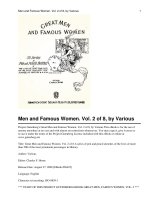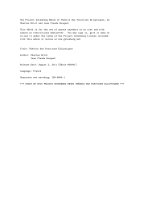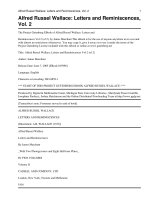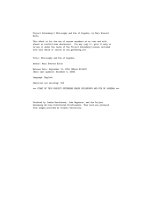The Eugenic Marriage, Vol 2 (of 4), by W. Grant Hague This eBook is for the use of anyone anywhere at no cost and with almost no restrictions whatsoever. You may copy it, give it away or re-use it under the terms of the Pro pptx
Bạn đang xem bản rút gọn của tài liệu. Xem và tải ngay bản đầy đủ của tài liệu tại đây (1.31 MB, 634 trang )
The Project Gutenberg EBook of The
Eugenic Marriage, Vol 2 (of 4),
by W. Grant Hague
This eBook is for the use of anyone
anywhere at no cost and with
almost no restrictions whatsoever. You
may copy it, give it away or
re-use it under the terms of the Project
Gutenberg License included
with this eBook or online at
www.gutenberg.org
Title: The Eugenic Marriage, Vol 2 (of
4)
A Personal Guide to the New Science of
Better Living and Better Babies
Author: W. Grant Hague
Release Date: March 16, 2008 [EBook
#24854]
Language: English
*** START OF THIS PROJECT GUTENBERG
EBOOK THE EUGENIC MARRIAGE ***
Produced by K.D. Thornton, Jason Isbell,
Josephine Paolucci
and the Online Distributed Proofreading
Team at
By courtesy of The New York Times
New York's Better Baby
Little Hiss Johanna Wiggers, who won
the first prize in New York's Better
Babies Contest by scoring 100 points, is
the type of little girl that will make the
best mothers, and the better race
tomorrow. Her score card showed; age,
28 months; weight, 33 lbs. 14 ozs.;
height, 35-1/2 inches; circumference of
head, 19-1/2 inches: circumference of
chest, 20 inches; lateral diameter of
chest, 6 inches; diameter of chest from
front to back, 4-1/2 inches; length of arm
to tip of middle finger, 14-1/2 inches;
length of leg to the sole of the foot, 161/2 inches; total, 100 points.
The Eugenic
Marriage
A Personal Guide to the
New Science of Better
Living and Better Babies
By W. GRANT
HAGUE, M. D.
College of Physicians and Surgeons
(Columbia University), New York;
Member of County Medical Society,
and of the American Medical
Association
In Four Volumes
VOLUME II
New York
THE REVIEW OF REVIEWS
COMPANY
1914
Copyright, 1913, by
W. Grant Hague
Copyright, 1914, by
W. Grant Hague
TABLE OF
CONTENTS
Sex Hygiene for the Boy
CHAPTER XII
BUILDING OUR BOYS
A word to parents—Interest in sex
hygiene—The
"Social
Evil"—Ten
millions suffering with venereal
diseases in the United States—
Immorality not confined to large cities—
Venereal diseases common in country
places—What are the consequences of
venereal disease to the boy?—
Gonorrhea, or clap—Symptoms of
gonorrhea in the male—Complications
of gonorrhea—Syphilis, or the "pox"—
How syphilis is acquired—Syphilis
attacks every organ in the body—Not
possible to tell when cured—The
chancre—Systematic, or constitutional
symptoms—Mucous patches and ulcers
—Syphilis of the blood vessels and
lymphatic glands—The interior organs
—Brain and spinal cord—The nose,
eye, ear, throat—Hair and nails—What
the boy with venereal disease may cause
in others—The infected wife—A girl's
fate when she marries—Young wife
rendered sterile—Young wife made to
miscarry—Is the husband to blame—
Building the man—Age of puberty
—"Internal Secretion" Page 139
CHAPTER XIII
THE PARENTS AND THE BOY
Abuse of the procreative function—The
continent life—Provide the environment
necessary to the clean life—The period
of procreative power—Self-abuse—
Masturbation—Treatment
of
masturbation—Night losses or wet
dreams—Causes of night emissions—
Sexual excesses—Treatment of sexual
excesses—What parents should know
about the so-called "social evil" before
speaking with authority to the boy—The
need of enlightenment in sexual matters
—"No one told me, I did not know"—
Fake medical treatment of venereal
diseases—Sowing wild oats—Should
circumcision be advised Page 153
Sex Hygiene for the Girl
CHAPTER XIV
A MOTHER'S DUTY TO HER
DAUGHTER
What a mother should tell her little girl
—Where do babies come from—How
baby birds and fish come from eggs—
How other animals have little nests of
their own—The duty of mothers to
instruct and direct—What a mother
should tell her daughter—Every mother
should regard this duty as sacred—
Every female child is a possible future
mother—Motherhood
the
highest
function of the sex—Health the one
necessary essential—Symptoms of the
first, or beginning menstruation—The
period of puberty in the female—
Changes in the reproductive organs at
puberty—The female generative organs
—The function of the reproductive
organs—The age of puberty in the
female—The function of the ovary—The
function
of
the
womb—Why
menstruation occurs every twenty-eight
days—The male or papa egg—The
function of the spermatozoa—"Tell the
whole
story"—"How
do
these
spermatozoa get there"—The union of
the species—"How can a baby live in
there for such a long time"—How the
baby gets its nourishment in the womb—
Girls must not become mothers Page 173
CHAPTER XV
PREPARING FOR MOTHERHOOD
Menstruation—Irregular menstruation—
Changes in the quantity of the flow—
How the womb is held in place—
Symptoms
of
menstruation—
Menstruation should not be accompanied
with pain—Don't give your daughters
patent
medicines,
or
"Female
Regulators"—Take your daughter to the
doctor—Leucorrhea in girls—Bathing
when menstruating—Constipation and
displaced
wombs—Dress
and
menstruation—Absence of menstruation,
or
amenorrhea—Treatment
of
amenorrhea—Painful menstruation, or
dysmenorrhea—Causes of dysmenorrhea
—Treatment of dysmenorrhea—Sterility
in the female—Conditions which affect
the fertility of women—Climate, station
in life, season of the year, age, the
tendency to miscarry—Causes of
sterility in the female—Displacement of
womb—Diseases of womb, ovaries, or
tubes—Malformations—Lacerations—
Tumors—
Leucorrhea—Physical
debility—Obesity—Special
poisons
—"Knack of miscarrying"—Miscarriage
—Cause of miscarriage—The course
and symptoms of miscarriage—What to
do when a miscarriage is threatened—
Treatment of threatened miscarriage—
Treatment of inevitable miscarriage—
After treatment of miscarriage—The
tendency to miscarriage Page 187
The Baby
CHAPTER XVI
HYGIENE AND DEVELOPMENT
OF THE BABY
What to prepare for the coming baby—
Care of the newly-born baby—The first
bath—Dressing the cord—Treatment
after the cord falls off—A pouting navel
—Bathing baby—Clothing the baby—
Baby's night clothes—Care of the eyes
—Care of the mouth and first teeth—
Care of the skin—Care of the genital
organs—Amusing baby—Temperature
in children—The teeth—The permanent
teeth—Care of the teeth—Dentition—
Treatment of teething—How to weigh
the baby—Average weight of a male
baby—Average weight of a female baby
—Average height of a male child—The
rate of growth of a child—Pulse rate in
children—Infant records, why they
should be kept—"Growing pains" Page
209
CHAPTER XVII
BABY'S FEEDING HABITS
Overfeeding baby—Intervals of feeding
—How long should a baby stay at the
breast—V
omiting between feedings—
Regularity of feeding—Why is regularity
of feeding important—A baby never
vomits—What is the significance of socalled vomiting after feedings—
Mother's milk that is unfit for baby—
Fresh air for baby—Air baths for baby
Page 223
CHAPTER XVIII
BABY'S GOOD AND BAD HABITS
—FOOD FORMULAS
Baby's bed—The proper way to lay
baby in bed—Baby should sleep by
itself—How long should a baby sleep—
Why a baby cries—The habitual crier—
The habit of feeding baby every time it
cries—The habit of walking the floor
with baby every time it cries—Jouncing,
or hobbling baby—Baby needs water to
drink—The evil habit of kissing baby—
Establishing
toilet
habits—Baby's
comforter—What can be done to lessen
the evil effects of the comforter habit—
Beef juice—Beef juice by the cold
process—Mutton broth—Mutton broth
with cornstarch or arrowroot—Chicken,
veal, and beef broths—Scraped beef or
meat pulp—Junket or curds and whey—
Whey—Barley water—Barley water
gruel or barley jelly—Rice, wheat or oat
water—Imperial
Granum—Albumen
water—Dried bread—Coddled egg
Page 235
Artificial Feeding
CHAPTER XIX
ARTIFICIAL FEEDING
Elementary
principles
of
milk
modification—The secret of the
efficiency of mothers' milk—Two
important factors in successful artificial
feeding—Every child is a problem in
itself—Proprietary foods of little value
as infant foods—Their value is in the
milk added to them—The credit belongs
to the cow—Difference between human
and cow's milk—What "top-milk"
feeding means—Utensils necessary for
home modification of milk—Artificial
feeding from birth to the twelfth month—
How to measure "top-milk"—Easy
bottle-feeding method—Condensed milk
feeding—Objections to condensed milk
feeding Page 249
CHAPTER XX
ARTIFICIAL FEEDING (continued)
How to prepare milk mixtures—
Sterilizing the food for the day's feeding
—How to test the temperature of the
food for baby—When to increase the
quality or quantity of food—Food
allowable during the first year in
addition to milk—Beef-juice—White of
egg—Orange juice—Peptonized milk—
The hot or immediate process—The
cold process—Partially peptonized milk
—Completely peptonized milk—Uses of
peptonized
milk—Objections
to
peptonized milk—What a mother should
know about baby's feeding bottle and
nipple—Should a mother put her baby
on artificial food if her supply of milk
during the first two weeks is not quite
enough to satisfy it—Certain conditions
justify the adoption of artificial feeding
from the beginning—Mothers' mistakes
in the preparation of artificial food—
Feeding during the second year—
Sample meals for a child three years of
age—The diet of older children—Meats,
vegetables, cereals, bread, desserts,
fruits Page 259
What Mothers Should Know
CHAPTER XXI
THE EDUCATION OF THE
MOTHER
What mothers should know about the
care of children during illness—A sick
child should be in bed—The diet of the
sick child—A child is the most helpless
living thing—The delicate child—How
to feed the delicate child—How to bathe
the delicate child—Airing the delicate
child—Habits of the delicate child—
Indiscriminate feeding—Poor appetite—
Loss of appetite—Treatment of loss of
appetite—Overeating in infancy—What
correct eating means—Bran as a food—
Breakfast for a child at school—Lunch
for a child at school—Bran muffins for
school children—Bran muffins in
constipation—Hysterical
children—
What a mother should know about
cathartics and how to give a dose of
castor oil—Castor oil—Calomel—
Citrate of Magnesium—When to use
castor oil—When to use calomel—
Vaccination—Time for vaccination—
Methods of vaccination—Symptoms of
successful vaccination Page 277
CHAPTER XXII
CONSTIPATION IN INFANTS AND
CHILDREN
Constipation—Regularity of bowel
function—The function of the stomach—









